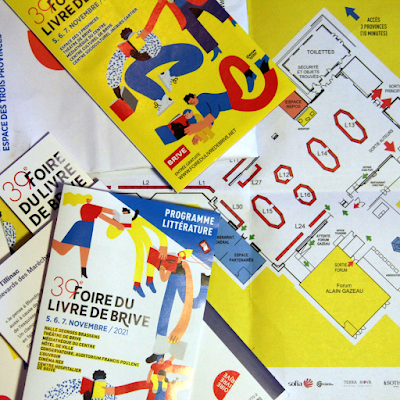Passing
through Savignac les Églises you find and indicator signaling Le
Causse de Savignac, arriving at the entrance a large sign welcomes
you to Le Causse de l’Isle. These seem to refer to the
same thing, though all communications of the government and tourist
offices use the latter. The leaflet presents ‘A nature reserve
covering 410 hectares’, and I somehow expecting an educational
facility with information panels on the local ecology. To my positive
surprise the area choose a different approach.
A
public consultation led to the creation of the Association for the
Sustainable Development of Causse de l'Isle (ADDCI) and the
Communauté de communes Causses et Rivières en Périgord, acquiring
the area in 2008. In 2010 the members of ADDCI voted in favor of a
development towards the cultural field. In 2011 and 2012 the first
two Land Art exhibitions on the Causse were organised, which
developed into an annual exhibition now called Art sur la Causse (more appropriate perhaps as it includes many in-situ installations).
At the same time the restoration of the small vernacular heritage
started.
I am not sure if it
was done on purpose, but the split between of the heritage
conservation in northern section. And looking towards the future
through Land art in the southern section, appears very smart to me.
As the original land art recognized ‘the future is build on the
ruins of the present’ or past. It is interesting to see ancient
sections of dry stacked wall morphing into something new, but it is
equally valuable to conserve the old.
I visited the 10th Art sur la Causse exhibition in summer 2020. Started in 2011
and 2012 as ‘Land Art exhibitions’, now an annual event more
appropriately named Art sur la Causse as it includes many
in-situ installations that should not be named as Land art. That said
I was quite impressed by Power Button by artist Wieger Franken
which I have since been able to spot on the satellite image of the
area. An interesting twist on the way Land art, the work consists of
a large ‘power button’ that was achieved by turning the soil in
the hope to recover a possible seed bank left behind by its former
land use.
A series of works by
Natalie Cosson titled Apparition/Disparition take existing dry
stacked walls as a starting point, playing with the ephemeral and
possibly confusing future generations with what actually happened
here. The exhibition featured a total of 63 works, 13 works that were
added in 2020. The trail is lightened up through a series of quotes,
literature excerpts and site specific practical jokes.
Looking forward to
the 2021 edition!
Find out more about the landscape, history, vegetation, the villages and life on the causse:
At La Min-sú de Terrasson, we assist travellers to organise itineraries, offering multi-language guidance to non-driving guests to savour the best of our castle-strewn riverlands and mesmerising prehistoric cave paintings. We offer you access to capture this rich cultural and historical heritage.
Our website: www.laminsudeterrasson.com
Sunday, January 31, 2021
Monday, January 25, 2021
Causse de Savignac
On this former military zone was used between 1953 to the 1995 for
shooting practice (still marked on many maps as ‘Champ de Tir’). A
nature reserve covering 410 hectares developed itself, now recognized as
a ‘Zone d’Intérêt Naturel, Ecologique, Floristique et Faunistique’
(ZNIEFF II) as the area had been covered by vegetation typical of the
dry South-West - Downy oaks, Junipers, Montpellier maples. Home to rare
species of butterfly, spider and lizard, with a rich dry stacked stone
heritage.
A 3.7 km long trail guides the visitor passed amazingly dense
clusters of dry stacked stone vernacular architecture. An architecture
without architects, built without mortar according to precise rules, in
particular of horizontal and vertical ‘calage’ (wedging). They are characterized by a so-called ‘à encorbellement’ internal vault which is detached from the roof and which is highly resistant to bad weather.
Today almost overgrown by forest, it is hard to imagine these
temporary shelters so closely linked to agriculture and particularly to
the cultivation of vines dating back to the times this area was indeed
covered by vineyards. The trail takes you passed Lassinée, the ensembles
of Mallaurin and Dardinelle and five sites of L’Henriette. Some of the
cabanes ‘à double parois’ have double exterior walls I have not seem elsewhere, and have not been able to find information on their purpose.
Far from the surrounding hamlets and villages, the cabanes served
as temporary shelters and refuges against the overwhelming heat of the
summers on the causse. To take a nap, shelter from storms or store
tools. The dry stacked stone constructions also had another purpose:
getting rid of the stones that the cultivator removed from the fields in
order to make space for crops. The area is crisscrossed by (low) walls,
dotted with 'queyrous' (pile of stones), 'guérites' (shelters leaned against or integrated into a wall), 'drailles' (path between low walls).
Subscribe to:
Comments (Atom)
The Foire du livre de Brive and the École de Brive.
The posters,bookmarks and leaflets were reprinted, the stickers had a whiff of ‘country’ this year. ‘ Ce qui nous unit tous les cinq n’est...

-
Chateau in the vineyards. Prestigious with centuries old tradition, cultivation was introduced under the roman empire, and the wine featur...
-
Skyline of Curemonte. Hugging the rocky ridge line overlooking the Maumont and Sourdoire valleys, Curemonte was build on a strategic defe...
-
Built on the banks of the Garonne river, city of art and history. You are not a wine lover?! Actually, the city of Bordeaux has much more ...












